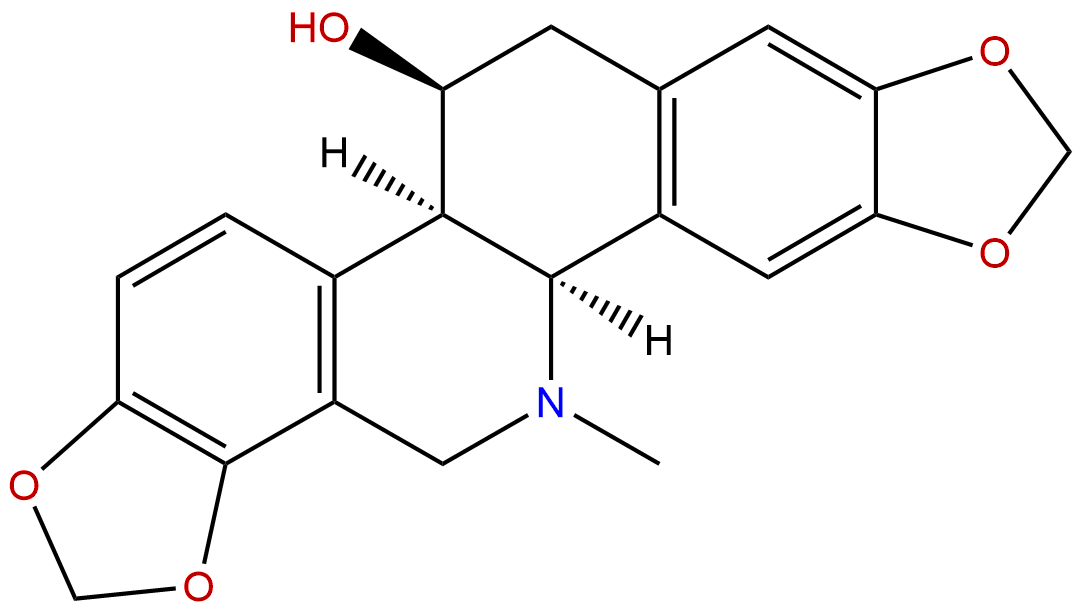
ChelidonineCAS No.:476-32-4
|
||||||||||
 |
|
|
||||||||

| Catalogue No.: | BP0342 |
| Formula: | C20H19NO5 |
| Mol Weight: | 353.374 |
Product name: Chelidonine
Synonym name: Stylophorine
Catalogue No.: BP0342
Cas No.: 476-32-4
Formula: C20H19NO5
Mol Weight: 353.374
Botanical Source: Chelidonium majus
Physical Description:
Type of Compound: Alkaloids
Purity: 95%~99%
Analysis Method: HPLC-DAD or/and HPLC-ELSD
Identification Method: Mass, NMR
Packing: Brown vial or HDPE plastic bottle
The product could be supplied from milligrams to grams
Inquire for bulk scale.
Description:
Chelidonine is a promising model compound for overcoming MDR and for enhancing cytotoxicity of chemotherapeutics, especially against leukaemia cells, its efficacy needs to be confirmed in animal models. Chelidonine may be a potential therapeutic agent against metastasis of invasive human cancer cells, exhibits anti‑migratory and anti‑invasive effects in MDA‑MB‑231 cells, by suppressing COL‑I‑induced integrin signaling, through inhibiting the formation of the IPP complex and subsequent down‑regulation of IPP downstream signaling molecules, such as Akt and ERK1/2.
References:
Chem Biol Interact. 2014 Sep 30;223C:141-149.
Multiple mechanisms of cell death induced by chelidonine in MCF-7 breast cancer cell line.
In a preliminary study screening anti-proliferative natural alkaloids, a very potent benzophenanthridine, Chelidonine showed strong cytotoxicity in cancer cells. While several modes of death have been identified, most of anti-cancer attempts have focused on stimulation of cells to undergo apoptosis.
METHODS AND RESULTS:
Chelidonine seems to trigger multiple mechanisms in MCF-7 breast cancer cells. It induces both apoptosis and autophagy modes of cell death in a dose dependent manner. Alteration of expression levels of bax/bcl2, and dapk1a by increasing concentration of Chelidonine approves switching the death mode from apoptosis induced by very low to autophagy by high concentrations of this compound. On the other hand, submicromolar concentrations of Chelidonine strongly suppressed telomerase at both enzyme activity and hTERT transcriptional level. Long exposure of the cells to 50 nanomolar concentration of Chelidonine considerably accelerated senescence.
CONCLUSIONS:
Altogether, Chelidonine may provide a promising chemistry from nature to treat cancer.
Phytomedicine. 2013 Feb 15;20(3-4):282-94.
Modulation of multidrug resistance in cancer cells by chelidonine and Chelidonium majus alkaloids.
Cancer cells often develop multidrug resistance (MDR) which is a multidimensional problem involving several mechanisms and targets.
METHODS AND RESULTS:
This study demonstrates that Chelidonine and an alkaloid extract from Chelidonium majus, which contains protoberberine and benzo[c]phenanthridine alkaloids, has the ability to overcome MDR of different cancer cell lines through interaction with ABC-transporters, CYP3A4 and GST, by induction of apoptosis, and cytotoxic effects. Chelidonine and the alkaloid extract inhibited P-gp/MDR1 activity in a concentration-dependent manner in Caco-2 and CEM/ADR5000 and reversed their doxorubicin resistance. In addition, Chelidonine and the alkaloid extract inhibited the activity of the drug modifying enzymes CYP3A4 and GST in a dose-dependent manner. The alkaloids induced apoptosis in MDR cells which was accompanied by an activation of caspase-3, -8,-6/9, and phosphatidyl serine (PS) exposure. cDNA arrays were applied to identify differentially expressed genes after treatment with Chelidonine and the alkaloid extract. The expression analysis identified a common set of regulated genes related to apoptosis, cell cycle, and drug metabolism. Treatment of Caco-2 cells with 50 μg/ml alkaloid extract and 50 μM Chelidonine for up to 48 h resulted in a significant decrease in mRNA levels of P-gp/MDR1, MRP1, BCRP, CYP3A4, GST, and hPXR and in a significant increase in caspase-3 and caspase-8 mRNA.
CONCLUSIONS:
Thus, Chelidonine is a promising model compound for overcoming MDR and for enhancing cytotoxicity of chemotherapeutics, especially against leukaemia cells. Its efficacy needs to be confirmed in animal models.
Toxicol Lett. 2013 Sep 12;222(1):10-22.
Cytotoxicity and apoptotic signalling cascade induced by chelidonine-loaded PLGA nanoparticles in HepG2 cells in vitro and bioavailability of nano-chelidonine in mice in vivo.
Poor oral bioavailability of Chelidonine, a bio-active ingredient of Chelidonium majus, showing anti-cancer potentials against cancer cells with multidrug resistance, makes its optimal use rather limited.
METHODS AND RESULTS:
To address this problem, we encapsulated Chelidonine in biodegradable poly(lactide-co-glycolide) (PLGA) polymers and evaluated nano-Chelidonine's (NCs) anti-cancer efficacy vis-à-vis free Chelidonine (FC) against HepG2 cells and also evaluated its bioavailability in mice. Physicochemical characteristics indicated that stable spherical NC were formed in nanometer size range (123±1.15 nm) with good yield (86.34±1.91%), better encapsulation efficiency (82.6±0.574%), negative surface charge (-19.6±2.48 mV) and ability of prolonged and sustained release of Chelidonine. Fourier transform infrared analysis revealed that NC resembled similar peaks as that of FC suggesting effective encapsulation in PLGA. NC exhibited rapid cellular uptake and stronger apoptotic effect (∼46.6% reduced IC₅₀ value) than FC, blocking HepG2 cells at G2/M phase. p53, cyclin-D1, Bax, Bcl-2, cytochrome c, Apaf-1, caspase-9 and caspase-3 expressions also corroborated well to suggest greater anticancer potentials of NC.
CONCLUSIONS:
Our in vivo studies demonstrated NC to be more bio-available than FC and showed a better tissue distribution profile without inducing any toxicity (100 mg/kg bw) in mice. Unlike FC, NC could permeate into brain tissue, indicating thereby NC's better potentials for use in therapeutic oncology.
HPLC of Chelidonine
